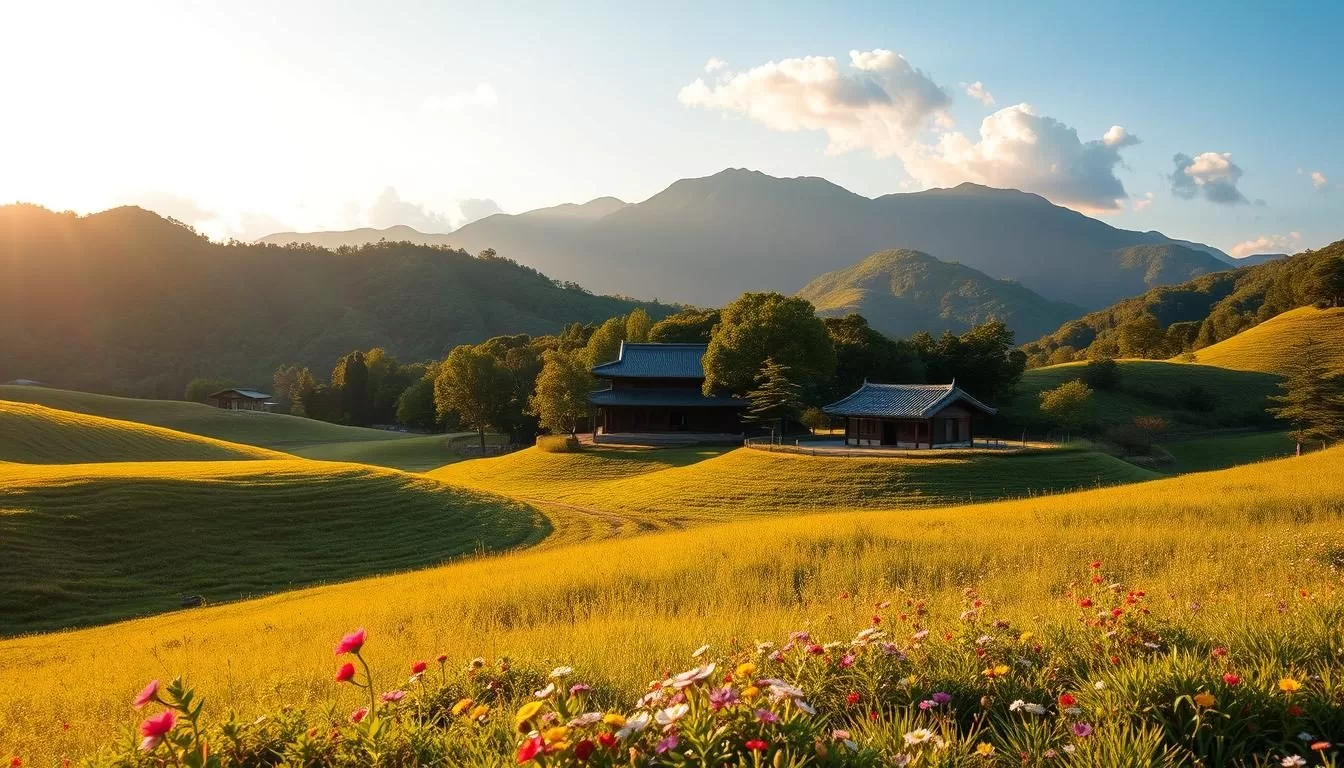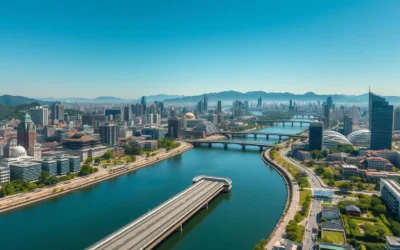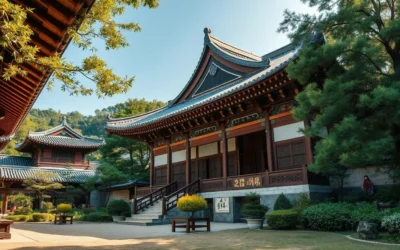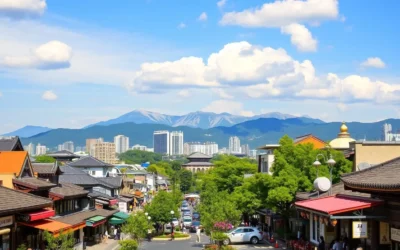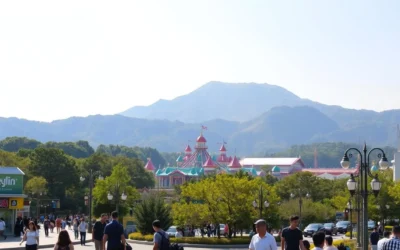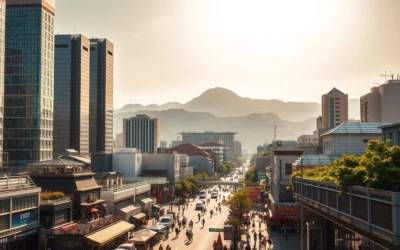✓ Accommodations ✓ Flights ✓ Rental Cars
Are you ready to explore one of South Korea‘s most beautiful regions? North Jeolla Province offers a diverse range of experiences throughout the year, from breathtaking natural landscapes to vibrant cultural festivals.
To make the most of your trip, understanding the local weather and seasonal variations is crucial. The right time to visit can greatly impact your experience, whether you’re interested in outdoor adventures or cultural events.
By considering factors such as temperatures and precipitation patterns, you can plan your visit during the most suitable month for your preferences. This guide will help you determine the ideal season for your travel plans.
Understanding North Jeolla Province’s Climate
The climate of North Jeolla Province, characterized by four distinct seasons, plays a significant role in shaping the travel experiences in this South Korean region. As you plan your trip, understanding these climatic variations is crucial for making the most of your visit.
Geographic Location and Climate Influences
North Jeolla Province’s geographic location significantly influences its climate. Situated in the southwestern part of the Korean Peninsula, it experiences a temperate climate with influences from its proximity to the ocean and its varied topography. The province’s climate is shaped by its mountains and valleys, which can lead to diverse weather conditions across different areas. This diversity means that travelers can experience a range of climates within a short distance, from the hot and humid summers to the cold winters.
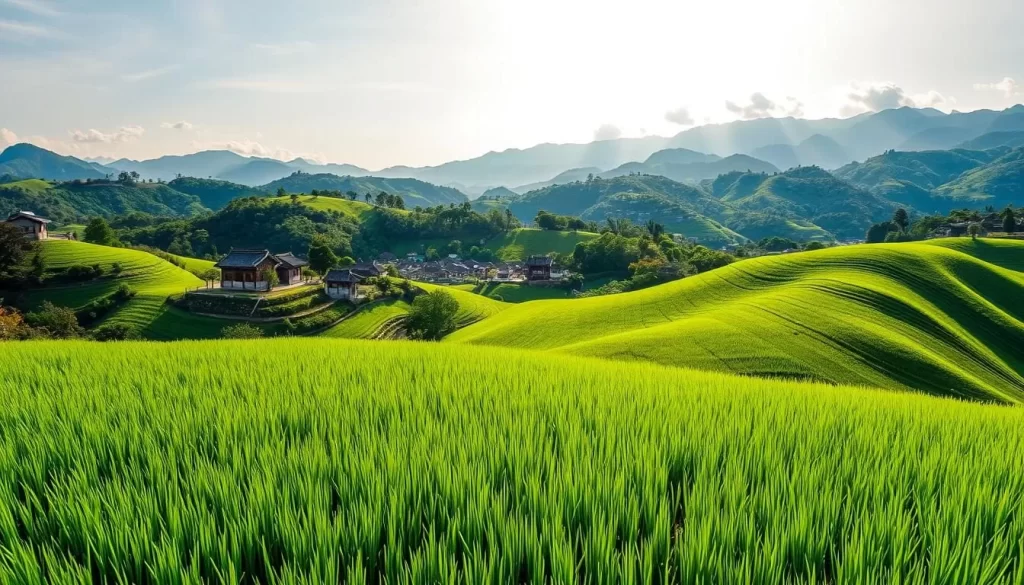
Seasonal Weather Patterns Overview
North Jeolla Province experiences four distinct seasons, each with its unique characteristics. Spring brings mild temperatures and blooming flowers, making it a popular time to visit. In contrast, summer is hot and humid, with the monsoon season bringing significant rainfall. Autumn offers comfortable temperatures and stunning fall foliage, while winter brings cold temperatures and occasional snowfall, especially in the mountainous regions. Understanding these seasonal patterns is key to planning your trip and enjoying the best that North Jeolla Province has to offer.
Spring in North Jeolla Province (March-May)
Spring in North Jeolla Province is a time of renewal and breathtaking scenery, making it an ideal period for a visit. As the cold winter fades away, the province transforms into a vibrant landscape, full of life and color.
March: Beginning of Spring
In March, North Jeolla Province starts to feel the warmth of spring. The temperatures begin to rise, making it a comfortable time to explore the outdoors. While it’s still a bit early for the full bloom of spring flowers, the landscapes start to become more vibrant.
April: Cherry Blossom Season
April is a highlight of the spring season in North Jeolla Province, with the famous cherry blossoms in full bloom. The temperatures are mild, ranging from 50°F to 65°F, making it perfect for outdoor activities like hiking and cycling. The province’s numerous parks and natural attractions are particularly popular during this time, as visitors come to enjoy the beautiful scenery.
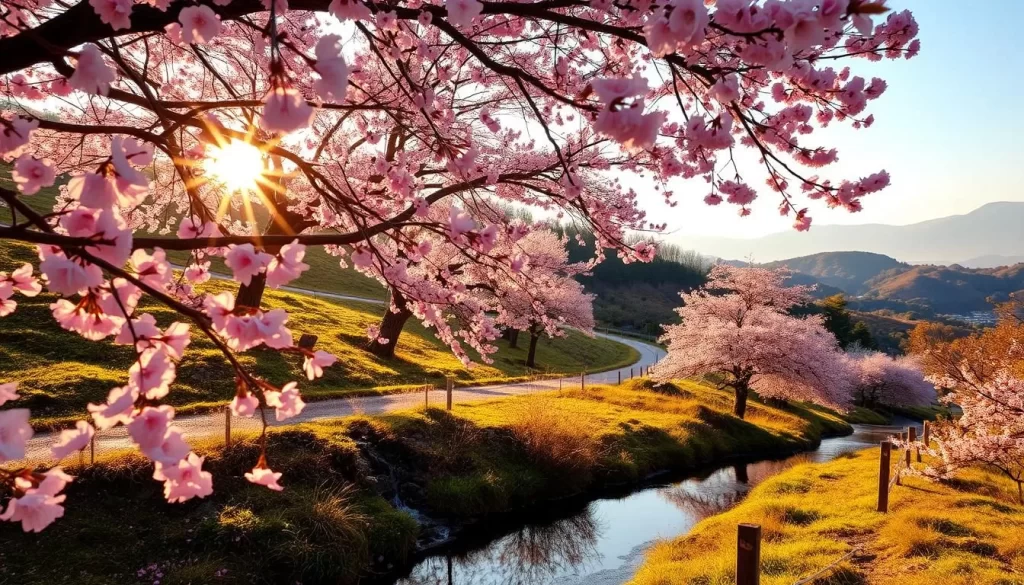
May: Ideal Temperatures and Outdoor Activities
May is considered one of the best times to visit North Jeolla Province. The weather is pleasant, with temperatures typically between 60°F and 75°F, ideal for outdoor activities. The landscape is lush and green, with spring flowers still in bloom. It’s an excellent time for visiting South Korea to enjoy the natural beauty and local agricultural festivals that celebrate the spring harvest.
- The comfortable weather makes May perfect for hiking, cycling, and exploring the province’s natural attractions.
- Local agricultural festivals offer a chance to experience the local culture and cuisine.
- The clear skies and moderate temperatures make it an excellent month for photography and sightseeing.
Overall, spring is a wonderful time to visit South Korea, especially North Jeolla Province, with its mild climate and vibrant landscapes making it an ideal destination for travelers looking to enjoy the outdoors.
Summer in North Jeolla Province (June-August)
North Jeolla Province comes alive during the summer months, offering a mix of cultural experiences and outdoor activities. As you plan your trip, it’s essential to understand the weather patterns and events that characterize this season.
June: Early Summer Conditions
In June, North Jeolla Province experiences early summer conditions, with temperatures gradually rising. The average high temperature is around 77°F (25°C), making it an ideal time for outdoor activities before the peak heat sets in. You can enjoy hiking and exploring the natural beauty of the province, including its lush forests and scenic landscapes.
July: Peak Humidity and Rainfall
July marks the peak of humidity and rainfall in North Jeolla Province. The temperatures soar, with averages ranging from 82°F to 86°F (28°C to 30°C), and the humidity makes it feel even hotter. While the rain can be a relief from the heat, it’s also a great time to enjoy indoor cultural events and festivals. Many local festivals take place during this month, offering a glimpse into the region’s rich cultural heritage.
August: Hot Weather and Festival Season
August remains hot and humid, with temperatures similar to July. However, this month is also known for its vibrant festival season. You can experience the local culture by attending one of the many summer festivals, which feature traditional music performances, food festivals, and cultural celebrations. It’s also an excellent time for water-based activities, as locals and tourists alike seek relief from the heat at beaches, rivers, and water parks.
Here’s a summary of the summer weather and activities in North Jeolla Province:
| Month | Average High Temperature | Main Activities |
|---|---|---|
| June | 77°F (25°C) | Hiking, outdoor exploration |
| July | 82°F-86°F (28°C-30°C) | Indoor cultural events, festivals |
| August | 82°F-84°F (28°C-29°C) | Summer festivals, water-based activities |
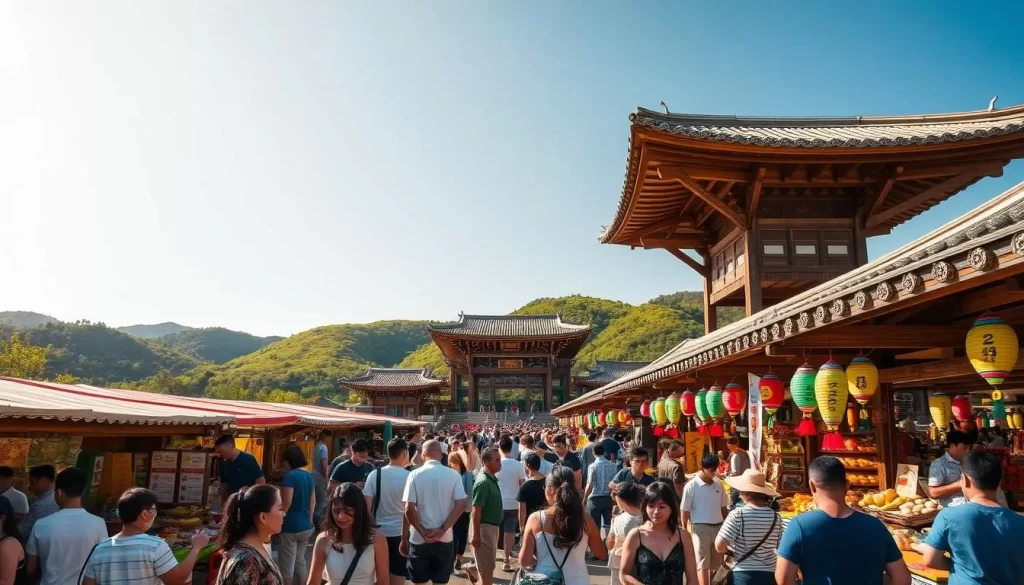
As you plan your trip to North Jeolla Province during the summer, consider the unique experiences each month offers. Whether you’re interested in cultural events, outdoor activities, or simply enjoying the local cuisine, there’s something for everyone in this vibrant region of South Korea.
Autumn in North Jeolla Province (September-November)
As the warmth of summer dissipates, autumn unfolds its splendor in North Jeolla Province. This season, spanning from September to November, brings a unique charm to the region, characterized by a gradual transition from the warmth of summer to the coolness of winter.
September: Transition to Fall
In September, North Jeolla Province begins its transition into fall, with temperatures gradually cooling down. The average highs range from 75°F to 80°F, making it an ideal time for outdoor activities. The landscape starts to display autumn colors, particularly in the higher elevations, setting the stage for the more vibrant foliage to come.
October: Fall Foliage and Comfortable Temperatures
October is a highlight of autumn in North Jeolla Province, with the fall foliage reaching its peak. The conditions are perfect for sightseeing, with comfortable temperatures ranging from 50°F to 70°F. The region’s mountains and valleys are painted with vibrant colors, making it a photographer’s paradise. It’s an ideal time for hiking and exploring the natural beauty of the province.
| Month | Average High (°F) | Average Low (°F) |
|---|---|---|
| September | 77 | 59 |
| October | 68 | 50 |
| November | 57 | 43 |
November: Late Autumn Conditions
By November, North Jeolla Province is in late autumn, with temperatures cooling significantly as the month progresses. The average temperatures range from 40°F to 60°F, with a noticeable crispness in the air, especially in the mornings and evenings. While the fall foliage starts to fade by the end of the month, the clear skies and good visibility make it excellent for photography and outdoor exploration. The thinning tourist crowds also offer a more peaceful experience at major attractions.
As the end month approaches, the province begins its transition toward winter, with occasional frost in the mornings, particularly in mountainous areas. This period offers a unique opportunity to experience the quieter side of North Jeolla Province before the winter season arrives.
Winter in North Jeolla Province (December-February)
The winter months in North Jeolla Province, spanning from December to February, offer a unique blend of cold weather and cultural festivities. As you plan your trip, understanding the nuances of each month can help you make the most of your visit.
December: Early Winter
December marks the beginning of winter in North Jeolla Province, with temperatures dropping significantly. You can expect cold conditions, with average temperatures ranging from 25°F to 40°F. It’s an ideal time to experience the province’s winter festivals and enjoy outdoor activities like skiing or ice skating.
January: Coldest Month and Winter Activities
January is the coldest month in North Jeolla Province, with temperatures often below freezing. Despite the chill, it’s a great time to enjoy winter sports and experience the local culture. You can participate in various festivals that take place during this month, celebrating the winter season.
February: Late Winter Conditions
By February, the province is still quite cold, but you might notice a slight rise in temperatures towards the end of the month. This period is significant because it often coincides with the Lunar New Year (Seollal), bringing vibrant celebrations and traditional performances throughout the province. It’s a unique time to experience the local culture and enjoy the remaining winter conditions before the onset of spring.
As the year progresses towards its end, December sets the stage for a chilly winter. The cold weather continues through January and into February, with the latter offering a slightly more moderate climate towards its end month.
| Month | Average Temperature Range (°F) | Notable Events |
|---|---|---|
| December | 25-40 | Winter Festivals |
| January | Below Freezing | Cultural Celebrations |
| February | 25-40 | Lunar New Year (Seollal) |
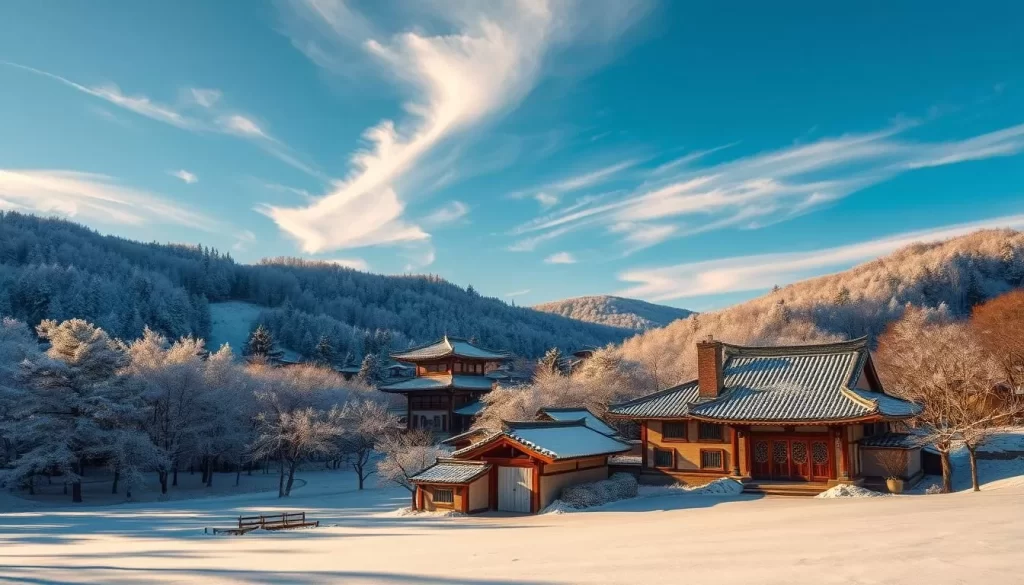
North Jeolla Province, South Korea: Best Months for a Weather-Savvy Trip
A weather-savvy trip to North Jeolla Province means selecting the months that align with your travel preferences. Whether you’re interested in cultural experiences, outdoor activities, or simply avoiding the crowds, timing is everything.
Best Time for Cultural Experiences and Festivals
North Jeolla Province is rich in cultural heritage, with numerous festivals throughout the year. Cherry blossom season in April is a highlight, attracting visitors from all over. For a more serene experience, consider visiting in late May or early June, when the weather is pleasant and festivals are still in full swing. You can enjoy cultural events without the peak season crowds.
Ideal Months for Outdoor Activities and Hiking
If you’re planning to engage in outdoor activities or hiking, the spring (March to May) and autumn (September to November) seasons offer ideal conditions. The weather is mild, making it perfect for exploring the province’s natural beauty. October is particularly popular for its fall foliage, but consider September or November for fewer crowds at popular sites.
When to Avoid Crowds and Peak Tourism
To avoid crowds, consider visiting during the shoulder seasons: late May to early June or late September to early October. These periods offer a balance between pleasant weather and smaller crowds. Early weekday mornings are also a good time to visit popular destinations, as tour groups and local visitors typically arrive later. By choosing the right times and being mindful of major Korean holidays, you can have a more relaxed and enjoyable trip.
Conclusion: Planning Your Perfect Trip to North Jeolla Province
Planning a trip to North Jeolla Province requires considering the best times to visit based on your preferences for weather and activities. The province offers a diverse range of experiences throughout the year, from the cherry blossoms in bloom during spring (April-May) to the spectacular fall foliage in autumn (September-October).
While summer brings lush landscapes and cultural festivals, it also comes with challenges like heat and humidity. In contrast, winter provides a serene landscape with fewer tourists, ideal for those who don’t mind the cold. To strike a balance between good weather and manageable crowds, consider visiting during the shoulder seasons.
Regardless of when you choose to visit, North Jeolla Province promises rich cultural experiences and beautiful landscapes. With proper planning and flexibility in your itinerary, you can create a weather-savvy trip that aligns with your travel preferences, making your journey to South Korea truly unforgettable.
The above is subject to change.
Check back often to TRAVEL.COM for the latest travel tips and deals.
